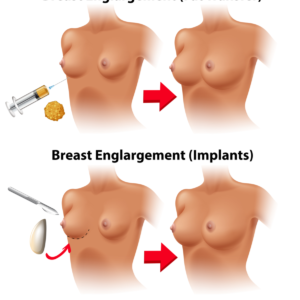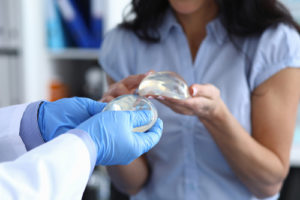Deciding between fat transfer to your breasts or Breast Implants? What are the advantages
When deciding on a fat transfer to the breast vs. breast implants, let’s first make sure we’re all on the same page in our understanding, because while the goal of both can be similar, they are very different procedures. A traditional breast augmentation, that is, a breast augmentation with implants, adds volume to the breasts by surgically placing a silicone or saline implant into the breast pocket. A fat transfer breast augmentation is a two-part process that takes excess, unwanted fat from one part of the body through liposuction and injects it into the breast to enhance their size and shape.
A big difference between a breast augmentation and a fat transfer breast augmentation is in the recovery and  scarring. In a fat transfer breast augmentation (generally speaking), your main recovery will actually be from the liposuction. You should give yourself about two weeks to recover: three days of solid downtime and relative downtime for the remainder of the two weeks. With traditional breast augmentation, you should expect a similar window of recovery: three days of solid downtime and relative downtime for the remainder of the two weeks. You can expect pain, swelling and sensitivity for a few weeks, but it should subside enough within the first few days to allow you to return to most of your activities without significant discomfort.
scarring. In a fat transfer breast augmentation (generally speaking), your main recovery will actually be from the liposuction. You should give yourself about two weeks to recover: three days of solid downtime and relative downtime for the remainder of the two weeks. With traditional breast augmentation, you should expect a similar window of recovery: three days of solid downtime and relative downtime for the remainder of the two weeks. You can expect pain, swelling and sensitivity for a few weeks, but it should subside enough within the first few days to allow you to return to most of your activities without significant discomfort.
When compared to the scars left from breast augmentation with implants, there really is no comparison. While your plastic surgeon will do everything possible to minimise scarring, there’s really no getting around the fact that the incision needed to place a breast implant is much larger than the tiny dot needed for a fat transfer breast augmentation. Therefore, the scars from an augmentation with implants is much more significant that the minimal, if any, scars from fat transfers.
 While both a fat transfer breast augmentation and breast implant surgery are overwhelmingly extremely safe procedures, there are always risks any time you undergo surgery. In a fat transfer to the breasts, the risks lie mostly in the liposuction part of the procedure, but generally include (like all procedures) infection and scarring. With both breast enhancement procedures (and any surgery performed on the breast), there is the potential to affect their functionality (i.e. nipple sensitivity and loss of breast feeding ability), though it’s important to note there’s no evidence that shows any loss of breast feeding ability caused by a fat transfer breast augmentation.
While both a fat transfer breast augmentation and breast implant surgery are overwhelmingly extremely safe procedures, there are always risks any time you undergo surgery. In a fat transfer to the breasts, the risks lie mostly in the liposuction part of the procedure, but generally include (like all procedures) infection and scarring. With both breast enhancement procedures (and any surgery performed on the breast), there is the potential to affect their functionality (i.e. nipple sensitivity and loss of breast feeding ability), though it’s important to note there’s no evidence that shows any loss of breast feeding ability caused by a fat transfer breast augmentation.
How to retain the most fat after a breast fat transfer?
You’re not going to retain all the fat that’s injected into your breast; some of it is going to disappear—but that’s supposed to happen! As with all fat transfers, not all of your transferred fat cells will survive, and while there’s not a lot you can do to make sure you retain the injected fat, the fat you do retain is permanent. You can expect to lose anywhere from 20%-50% of the fat transferred, so your doctor will transfer more to compensate. This means that your final results, once your swelling has gone down, are your final results.
Do you want to learn more about Barrett Plastic Surgery? Keep up to date by subscribing to our blog and following us on social media at Twitter, TikTok, Instagram, Realself, YouTube, Snapchat, Yelp, and Facebook for updates.
Thank you for visiting!




0